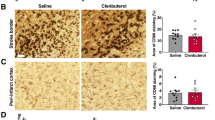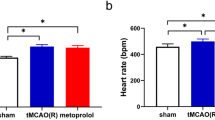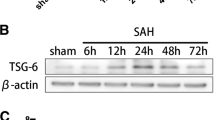Abstract
Stoke results in activation of the sympathetic nervous system (SNS), inducing systemic immunosuppression. However, the potential mechanisms underlying stroke-induced immunosuppression remain unclear. Here, we determined the SNS effects on functional outcome and explored the interactions among SNS, β-arrestin2 and nuclear factor-κB (NF-κB) after experimental stroke in rats. In the current study, stroke was induced by a transient middle cerebral artery occlusion (MCAO) in rats, and SNS activity was inhibited by intraperitoneal injection of 6-hydroxydopamine HBr (6-OHDA). 7.0 T Micro-MRI and Longa score were employed to assess the functional outcome after stroke. Flow cytometry and ELISA assay were used to measure the expression of MHC class II, tumor necrosis factor-α (TNF-α) and interferon-γ (IFN-γ). Western blot was conducted to analyze β-arrestin2 and NF-κB protein expression levels after experimental stroke. We found significantly increased infarct volumes and functional impairment after MCAO at different post-surgery time points, which were not aggravated by 6-OHDA treatment. SNS blockade partially reversed the expression of MHC class II after stroke over time, as well as TNF-α and IFN-γ levels in lipopolysaccharide-stimulated macrophages in vitro. Treatment of MCAO rats with SNS-inhibitor significantly diminished NF-κB activation and enhanced β-arrestin2 expression after stroke. This study suggests that pharmacological SNS inhibition dose not aggravate functional outcome after stroke. Stroke-induced immunosuppression may be involved in the SNS–β-arrestin2–NF-κB pathway.





Similar content being viewed by others
Abbreviations
- SNS:
-
Sympathetic nervous system
- NF-κB:
-
Nuclear factor-κB
- MCAO:
-
Middle cerebral artery occlusion
- TNF-α:
-
Tumor necrosis factor-α
- IFN-γ:
-
Interferon-γ
- LPS:
-
Lipopolysaccharide
- MRI:
-
Magnetic resonance imaging
- SPF:
-
Specific pathogen-free
- 6-OHDA:
-
6-Hydroxydopamine HBr
- EDTA:
-
Ethylenediaminetetraacetate
- SDS-PAGE:
-
Sodium dodecyl sulfate polyacrylamide gel electrophoresis
- ELISA:
-
Enzyme-linked immunosorbent assays
- AM:
-
Alveolar macrophage
- β2AR:
-
β2-Adrenergic receptor
References
Katzan IL, Cebul RD, Husak SH, Dawson NV, Baker DW (2003) The effect of pneumonia on mortality among patients hospitalized for acute stroke. Neurology 60(4):620–625
Langhorne P, Stott DJ, Robertson L, MacDonald J, Jones L, McAlpine C et al (2000) Medical complications after stroke: a multicenter study. Stroke 31(6):1223–1229
Koennecke HC, Belz W, Berfelde D, Endres M, Fitzek S, Hamilton F et al (2011) Factors influencing in-hospital mortality and morbidity in patients treated on a stroke unit. Neurology 77(10):965–972. doi:10.1212/WNL.0b013e31822dc795
Chamorro A, Amaro S, Vargas M, Obach V, Cervera A, Gomez-Choco M et al (2007) Catecholamines, infection, and death in acute ischemic stroke. J Neurol Sci 252(1):29–35. doi:10.1016/j.jns.2006.10.001
Meisel C, Meisel A (2011) Suppressing immunosuppression after stroke. N Engl J Med 365(22):2134–2136. doi:10.1056/NEJMcibr1112454
Wong CH, Jenne CN, Lee WY, Leger C, Kubes P (2011) Functional innervation of hepatic iNKT cells is immunosuppressive following stroke. Science 334(6052):101–105. doi:10.1126/science.1210301
Hattori Y, Moriwaki A, Hori Y (1990) Biphasic effects of polarizing current on adenosine-sensitive generation of cyclic AMP in rat cerebral cortex. Neurosci Lett 116(3):320–324
Macrez R, Ali C, Toutirais O, Le Mauff B, Defer G, Dirnagl U et al (2011) Stroke and the immune system: from pathophysiology to new therapeutic strategies. Lancet Neurol 10(5):471–480. doi:10.1016/S1474-4422(11)70066-7
Meisel C, Schwab JM, Prass K, Meisel A, Dirnagl U (2005) Central nervous system injury-induced immune deficiency syndrome. Nat Rev Neurosci 6(10):775–786. doi:10.1038/nrn1765
Woiciechowsky C, Schoning B, Lanksch WR, Volk HD, Docke WD (1999) Mechanisms of brain-mediated systemic anti-inflammatory syndrome causing immunodepression. J Mol Med (Berl). 77(11):769–780
Czlonkowska A, Cyrta B, Korlak J (1979) Immunological observations on patients with acute cerebral vascular disease. J Neurol Sci 43(3):455–464
Chamorro A, Urra X, Planas AM (2007) Infection after acute ischemic stroke: a manifestation of brain-induced immunodepression. Stroke 38(3):1097–1103. doi:10.1161/01.STR.0000258346.68966.9d
Klehmet J, Harms H, Richter M, Prass K, Volk HD, Dirnagl U et al (2009) Stroke-induced immunodepression and post-stroke infections: lessons from the preventive antibacterial therapy in stroke trial. Neuroscience 158(3):1184–1193. doi:10.1016/j.neuroscience.2008.07.044
Prass K, Meisel C, Hoflich C, Braun J, Halle E, Wolf T et al (2003) Stroke-induced immunodeficiency promotes spontaneous bacterial infections and is mediated by sympathetic activation reversal by poststroke T helper cell type 1-like immunostimulation. J Exp Med 198(5):725–736. doi:10.1084/jem.20021098
Mosser DM, Edwards JP (2008) Exploring the full spectrum of macrophage activation. Nat Rev Immunol 8(12):958–969. doi:10.1038/nri2448
Lawrence T, Natoli G (2011) Transcriptional regulation of macrophage polarization: enabling diversity with identity. Nat Rev Immunol 11(11):750–761. doi:10.1038/nri3088
Barron L, Wynn TA (2011) Fibrosis is regulated by Th2 and Th17 responses and by dynamic interactions between fibroblasts and macrophages. Am J Physiol Gastrointest Liver Physiol 300(5):G723–G728. doi:10.1152/ajpgi.00414.2010
Gordon S (2003) Alternative activation of macrophages. Nat Rev Immunol 3(1):23–35. doi:10.1038/nri978
Ivashkiv LB (2011) Inflammatory signaling in macrophages: transitions from acute to tolerant and alternative activation states. Eur J Immunol 41(9):2477–2481. doi:10.1002/eji.201141783
Alvira CM (2014) Nuclear factor-kappa-B signaling in lung development and disease: one pathway, numerous functions. Birth Defects Res A Clin Mol Teratol 100(3):202–216. doi:10.1002/bdra.23233
Gao H, Sun Y, Wu Y, Luan B, Wang Y, Qu B et al (2004) Identification of beta-arrestin2 as a G protein-coupled receptor-stimulated regulator of NF-kappaB pathways. Mol Cell 14(3):303–317
Grailer JJ, Haggadone MD, Sarma JV, Zetoune FS, Ward PA (2014) Induction of M2 regulatory macrophages through the beta2-adrenergic receptor with protection during endotoxemia and acute lung injury. J Innate Immun 6(5):607–618. doi:10.1159/000358524
Feibel JH, Hardy PM, Campbell RG, Goldstein MN, Joynt RJ (1977) Prognostic value of the stress response following stroke. JAMA 238(13):1374–1376
Yan FL, Zhang JH (2014) Role of the sympathetic nervous system and spleen in experimental stroke-induced immunodepression. Med Sci Monit 20:2489–2496. doi:10.12659/MSM.890844
Longa EZ, Weinstein PR, Carlson S, Cummins R (1989) Reversible middle cerebral artery occlusion without craniectomy in rats. Stroke 20(1):84–91
Gerriets T, Stolz E, Walberer M, Muller C, Kluge A, Bachmann A et al (2004) Noninvasive quantification of brain edema and the space-occupying effect in rat stroke models using magnetic resonance imaging. Stroke 35(2):566–571. doi:10.1161/01.STR.0000113692.38574.57
Wang J, Yu L, Jiang C, Fu X, Liu X, Wang M et al (2015) Cerebral ischemia increases bone marrow CD4+ CD25+ FoxP3+ regulatory T cells in mice via signals from sympathetic nervous system. Brain Behav Immun 43:172–183. doi:10.1016/j.bbi.2014.07.022
Wirth T, Westendorf AM, Bloemker D, Wildmann J, Engler H, Mollerus S et al (2014) The sympathetic nervous system modulates CD4(+)Foxp3(+) regulatory T cells via noradrenaline-dependent apoptosis in a murine model of lymphoproliferative disease. Brain Behav Immun 38:100–110. doi:10.1016/j.bbi.2014.01.007
Zhang DP, Yan FL, Xu HQ, Zhu YX, Yin Y, Lu HQ (2009) A decrease of human leucocyte antigen-DR expression on monocytes in peripheral blood predicts stroke-associated infection in critically-ill patients with acute stroke. Eur J Neurol 16(4):498–505. doi:10.1111/j.1468-1331.2008.02512.x
Reddy DB, Reddanna P (2009) Chebulagic acid (CA) attenuates LPS-induced inflammation by suppressing NF-kappaB and MAPK activation in RAW 264.7 macrophages. Biochem Biophys Res Commun 381(1):112–117. doi:10.1016/j.bbrc.2009.02.022
Lee KW, Lee Y, Kim DS, Kwon HJ (2006) Direct role of NF-kappaB activation in Toll-like receptor-triggered HLA-DRA expression. Eur J Immunol 36(5):1254–1266. doi:10.1002/eji.200535577
Failli V, Kopp MA, Gericke C, Martus P, Klingbeil S, Brommer B et al (2012) Functional neurological recovery after spinal cord injury is impaired in patients with infections. Brain 135(Pt 11):3238–3250. doi:10.1093/brain/aws267
Sander D, Winbeck K, Klingelhofer J, Etgen T, Conrad B (2001) Prognostic relevance of pathological sympathetic activation after acute thromboembolic stroke. Neurology 57(5):833–838
Meyer JS, Stoica E, Pascu I, Shimazu K, Hartmann A (1973) Catecholamine concentrations in CSF and plasma of patients with cerebral infarction and haemorrhage. Brain 96(2):277–288
Sander D, Klingelhofer J (1995) Changes of circadian blood pressure patterns and cardiovascular parameters indicate lateralization of sympathetic activation following hemispheric brain infarction. J Neurol 242(5):313–318
Becker KJ, Kindrick DL, Lester MP, Shea C, Ye ZC (2005) Sensitization to brain antigens after stroke is augmented by lipopolysaccharide. J Cereb Blood Flow Metab 25(12):1634–1644. doi:10.1038/sj.jcbfm.9600160
Bornstein NM, Aronovich B, Korczyn AD, Shavit S, Michaelson DM, Chapman J (2001) Antibodies to brain antigens following stroke. Neurology 56(4):529–530
Dambinova SA, Khounteev GA, Izykenova GA, Zavolokov IG, Ilyukhina AY, Skoromets AA (2003) Blood test detecting autoantibodies to N-methyl-D-aspartate neuroreceptors for evaluation of patients with transient ischemic attack and stroke. Clin Chem 49(10):1752–1762
Kleinschnitz C, Schwab N, Kraft P, Hagedorn I, Dreykluft A, Schwarz T et al (2010) Early detrimental T-cell effects in experimental cerebral ischemia are neither related to adaptive immunity nor thrombus formation. Blood 115(18):3835–3842. doi:10.1182/blood-2009-10-249078
Romer C, Engel O, Winek K, Hochmeister S, Zhang T, Royl G et al (2015) Blocking stroke-induced immunodeficiency increases CNS antigen-specific autoreactivity but does not worsen functional outcome after experimental stroke. J Neurosci 35(20):7777–7794. doi:10.1523/JNEUROSCI.1532-14.2015
Hauben E, Nevo U, Yoles E, Moalem G, Agranov E, Mor F et al (2000) Autoimmune T cells as potential neuroprotective therapy for spinal cord injury. Lancet 355(9200):286–287
Lewitus GM, Kipnis J, Avidan H, Ben-Nun A, Schwartz M (2006) Neuroprotection induced by mucosal tolerance is epitope-dependent: conflicting effects in different strains. J Neuroimmunol 175(1–2):31–38. doi:10.1016/j.jneuroim.2006.02.013
Becker KJ, McCarron RM, Ruetzler C, Laban O, Sternberg E, Flanders KC et al (1997) Immunologic tolerance to myelin basic protein decreases stroke size after transient focal cerebral ischemia. Proc Natl Acad Sci USA 94(20):10873–10878
Moalem G, Leibowitz-Amit R, Yoles E, Mor F, Cohen IR, Schwartz M (1999) Autoimmune T cells protect neurons from secondary degeneration after central nervous system axotomy. Nat Med 5(1):49–55. doi:10.1038/4734
Jones TB, Basso DM, Sodhi A, Pan JZ, Hart RP, MacCallum RC et al (2002) Pathological CNS autoimmune disease triggered by traumatic spinal cord injury: implications for autoimmune vaccine therapy. J Neurosci 22(7):2690–2700
Steimle V, Siegrist CA, Mottet A, Lisowska-Grospierre B, Mach B (1994) Regulation of MHC class II expression by interferon-gamma mediated by the transactivator gene CIITA. Science 265(5168):106–109
Baldwin AS Jr (2001) Series introduction: the transcription factor NF-kappaB and human disease. J Clin Invest 107(1):3–6. doi:10.1172/JCI11891
Baldwin AS Jr (1996) The NF-kappa B and I kappa B proteins: new discoveries and insights. Annu Rev Immunol 14:649–683. doi:10.1146/annurev.immunol.14.1.649
van der Poll T, Jansen J, Endert E, Sauerwein HP, van Deventer SJ (1994) Noradrenaline inhibits lipopolysaccharide-induced tumor necrosis factor and interleukin 6 production in human whole blood. Infect Immun 62(5):2046–2050
Feng D, Ling WH, Duan RD (2010) Lycopene suppresses LPS-induced NO and IL-6 production by inhibiting the activation of ERK, p38MAPK, and NF-kappaB in macrophages. Inflamm Res 59(2):115–121. doi:10.1007/s00011-009-0077-8
Acknowledgments
This study was supported by the National Nature Science Foundation of China (No. 81271336).
Authors’ contributions
Q.-W.D. participated in the design of the study and performed the statistical analysis. H.W. carried out animal experiments and cell culture. H.Y., F.-L.X. L.Z. and H.-Q.Z. performed other experiments and prepared figures. F.-L.Y. conceived of the study, and participated in its design and coordination and helped to draft the manuscript. All authors read and approved the final manuscript.
Author information
Authors and Affiliations
Corresponding author
Ethics declarations
Conflict of interest
The authors declare that they have no conflict of interest.
Ethical approval
All experimental procedures were conducted in accordance with the US National Institutes of Health guidelines and were approved by the Southeast University Committee for the Use and Care of Animals.
Rights and permissions
About this article
Cite this article
Deng, QW., Yang, H., Yan, FL. et al. Blocking Sympathetic Nervous System Reverses Partially Stroke-Induced Immunosuppression but does not Aggravate Functional Outcome After Experimental Stroke in Rats. Neurochem Res 41, 1877–1886 (2016). https://doi.org/10.1007/s11064-016-1899-8
Received:
Revised:
Accepted:
Published:
Issue Date:
DOI: https://doi.org/10.1007/s11064-016-1899-8




